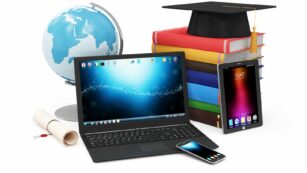In the fast-paced world of the 21st century, technology has become a cornerstone in shaping educational landscapes. Its integration into classrooms around the globe has not only revolutionized the way educators teach but also how students learn. From personalized learning experiences to instant access to a wealth of information, technology’s role in education is both transformative and indispensable.
Importance of Technology in Education
A Historical Perspective
 The journey of technology in education begins from the times of chalkboards to the present day’s advanced digital learning environments. Initially, the role of technology was minimal, often limited to enhancing administrative efficiency rather than directly contributing to the learning process. However, the late 20th century marked a turning point as computers started making their way into classrooms, albeit sparingly. This period witnessed the first wave of transformative change, setting a foundation for technology’s pivotal role in education. Innovations like projectors, televisions, and early personal computers introduced new methods of delivering educational content, albeit to a limited extent.
The journey of technology in education begins from the times of chalkboards to the present day’s advanced digital learning environments. Initially, the role of technology was minimal, often limited to enhancing administrative efficiency rather than directly contributing to the learning process. However, the late 20th century marked a turning point as computers started making their way into classrooms, albeit sparingly. This period witnessed the first wave of transformative change, setting a foundation for technology’s pivotal role in education. Innovations like projectors, televisions, and early personal computers introduced new methods of delivering educational content, albeit to a limited extent.
Today’s Technological Landscape in Schools
Fast forward to the present day, the technological landscape in schools has evolved remarkably. Digital learning tools, ranging from tablets and laptops to specialized software and apps, have become integral to the educational experience. Interactive whiteboards and digital projectors facilitate dynamic classroom interactions, allowing for real-time annotated lectures and multimedia presentations. Online educational platforms and resources provide unparalleled access to information, breaking down geographical and financial barriers to education. Virtual classrooms and distance learning programs ensure continuity of education, making learning accessible anywhere, anytime.
Moreover, the significance of technology in education today extends beyond mere access to information. It encompasses personalized learning experiences tailored to individual learners’ needs and capabilities. Data analytics tools and educational software enable educators to monitor students’ progress more accurately, identifying areas of strength and weakness with precision. This facilitates a more targeted teaching approach, enhancing learning outcomes. Furthermore, technology empowers students to take an active role in their learning journey, fostering a sense of autonomy and encouraging critical thinking and problem-solving skills.
Enhancing Learning Experiences with Technology
Interactive and Engaging Learning Tools
 Interactive and engaging learning tools stand at the forefront of enhancing education through technology. These tools transform traditional learning environments into dynamic and participatory spaces, encouraging students to take an active role in their education. From virtual reality (VR) that immerses learners in three-dimensional environments to educational software that adapts to individual learning styles, technology offers diverse avenues for engagement.
Interactive and engaging learning tools stand at the forefront of enhancing education through technology. These tools transform traditional learning environments into dynamic and participatory spaces, encouraging students to take an active role in their education. From virtual reality (VR) that immerses learners in three-dimensional environments to educational software that adapts to individual learning styles, technology offers diverse avenues for engagement.
Smartboards and interactive whiteboards have replaced chalkboards, allowing teachers to integrate multimedia resources into lessons. Such tools not only grab students’ attention but also cater to various learning preferences, be they visual, auditory, or kinesthetic. With the touch of a finger, teachers can pull up historical documents, scientific simulations, or mathematical puzzles, making complex concepts more accessible and understandable.
Online platforms and learning management systems (LMS) facilitate collaborative learning, enabling students to work together on projects, share resources, and discuss ideas, even when physically apart. Platforms like Google Classroom and Moodle streamline assignment distribution, feedback, and grading, enhancing communication between teachers and students.
Overcoming Geographical and Physical Barriers
 Technology plays an integral role in dismantling the traditional constraints of geography and physical accessibility in education. It allows students, regardless of their location or physical capabilities, to access a wealth of information and educational resources. Online learning platforms and virtual classrooms break down the physical walls of conventional classrooms, enabling students in remote or underserved areas to participate in high-quality education. Furthermore, assistive educational technologies ensure that students with disabilities experience fewer barriers to learning, offering tools and resources that adapt to their needs. Thus, technology significantly expands the reach of education, making it inclusive and accessible to a broader audience.
Technology plays an integral role in dismantling the traditional constraints of geography and physical accessibility in education. It allows students, regardless of their location or physical capabilities, to access a wealth of information and educational resources. Online learning platforms and virtual classrooms break down the physical walls of conventional classrooms, enabling students in remote or underserved areas to participate in high-quality education. Furthermore, assistive educational technologies ensure that students with disabilities experience fewer barriers to learning, offering tools and resources that adapt to their needs. Thus, technology significantly expands the reach of education, making it inclusive and accessible to a broader audience.
Preparing Students for the Digital Age
In the digital age, the importance of technology in education becomes increasingly apparent as it equips students with the necessary skills for a technology-centric future. By integrating technological tools in learning environments, students not only benefit from enhanced educational experiences but also develop competencies in critical thinking, problem-solving, and digital literacy. These skills are indispensable for navigating the complexities of the modern workplace and society. Technology’s role in education transcends traditional learning methods, fostering a generation of learners ready to thrive in the digital world.

